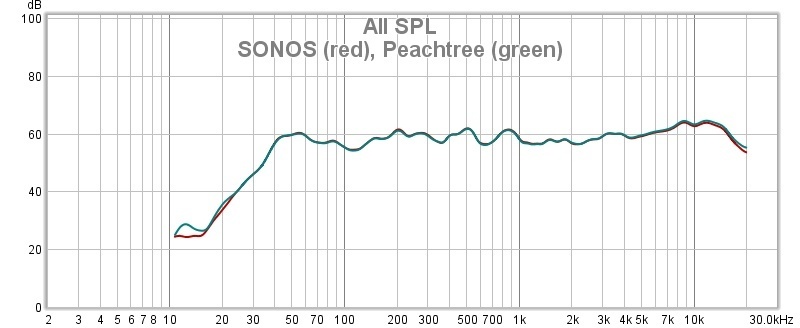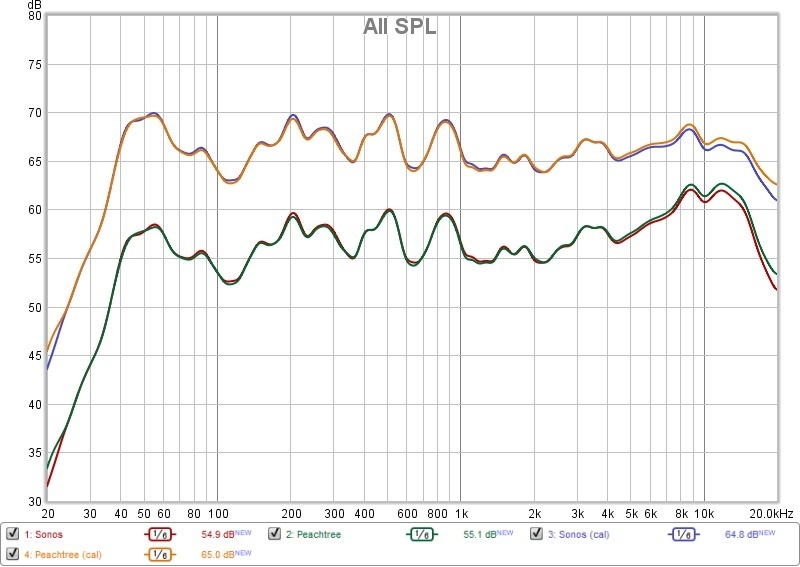There have been questions about the high frequency response of the Sonos Amp. User hodgeal posted a very interesting plot showing the frequency response of the Sonos Amp using the software REW. It didn't show excessive high frequencies in that single test.
I had the opportunity to compare the Sonos amp to my Peachtree amp using the same software (which is very useful and easy to use - thanks hodgeal), and this provides a comparative test of the Sonos Amp frequency response.
The Peachtree Nova 125 SE amp is well-respected in the audio community. It is a class D digital amp, same as the Sonos Amp, but as far as I can tell uses different chips. The test uses Duntech Marquis speakers and a Studio Projects C1 microphone. The mic is setup on-axis at a distance of 120cm, which is pretty standard. But none of the details should matter because this is a comparison under identical conditions - I simply swapped amps and repeated the test.
And the results?
As you can see, the amps are almost identical. Ignore low frequencies - they vary from test to test even with the same amp below about 30Hz. At high frequencies, above about 4kHz, the Peachtree gets gradually brighter, ending up being about 1.5dB louder at 20kHz. This would be imperceptible to pretty much everyone.
Note that there is a slight increase in high frequencies above about 7kHz for both amps, so this could be the speakers. However, I think this is due to the frequency response of the microphone - the specifications show a similar slight increase.
Cheers, Peter.
This topic has been closed for further comments. You can use the search bar to find a similar topic, or create a new one by clicking Create Topic at the top of the page.
Page 2 / 4
Interesting. This fits what the M2 shows if we assume the Sonos Amp is dialed in for lower impedance. Then the amp might be a little bright with higher impedance speakers. I ordered some power resistors so maybe I can do some simple tests with dummy loads. But first I emailed Sonos to ask if they have any curves that they are able to share. I don't know if Sonos people are monitoring this thread and might chime in?
DDFA uses some feedback taken right at the speaker connections and so I thought it would compensate for different loads. But the M2 tests seem to show that this might only work well over a limited range of loading. Maybe Qualcomm has improved this with newer DDFA technology?
Peter, if you can answer this after measurements, questions that arose in another thread:
What happens at the speaker terminals of the Sonos Amp if a blank jack is plugged into the Sub out jack? Are the speaker terminals then denied frequencies below the crossover setting of 80Hz even if there is nothing at the other end of the jack? And then does turning the Sub on/off in room settings for the Sonos amp in the Sonos app have any impact on what happens at the speaker terminals? Are low frequencies restored to the speaker terminals with the jack plugged in, but the Sub setting on off?
What happens at the speaker terminals of the Sonos Amp if a blank jack is plugged into the Sub out jack? Are the speaker terminals then denied frequencies below the crossover setting of 80Hz even if there is nothing at the other end of the jack? And then does turning the Sub on/off in room settings for the Sonos amp in the Sonos app have any impact on what happens at the speaker terminals? Are low frequencies restored to the speaker terminals with the jack plugged in, but the Sub setting on off?
Peter many thanks for the measurements and the super informative analysis. Very very interesting indeed 🙂. If (big IF) that frequency response is carried over to other setups then I wonder whether the measured relative rise at 6kHz and above is partly responsible for the perceived brightness of the amp? I also understand you suggest that this rise is due to the mic frequency response. Difficult to reach a conclusion on how this measured response will correlate with perceived sound of course but if we assume this is what reaches the ear then it is worth noting that in your case we can observe a rise that reaches about +3dB at 8 - 9 kHz. To quote my sound engineer friend, this is the 'presence - sibilance' range. In contrast we see a drop of about -5dB in the 1-3 kHz range which is in the vocal range. Comparing the two we can consider a total of 8db relative difference between the vocal range and the sibilance - presence range which may lead to a perceived sound 'flavour' as the reviews describe? Having said that, the peachtree shows a very similar frequency response in your setting so no big difference there. Of course this response is very context dependent (speakers + Room acoustics) so difficult to draw conclusions.
In my case, I immediately felt I had to turn down the treble of the Sonos Amp by 3-4 clicks as soon as I started listening to it. I did turn off the loudness before listening. The 's' sounds felt very pronounced to my ears. This was at my dealer's listening room with a pair of Dynaudio M10 speakers which I also have at home. This does not necessarily mean the amp is bright for everyone though. I know I am very very sensitive to frequencies from 3kHz and above and I usually adjust these down if I can. This is probably the reason why I always the Sonos Trueplay results in a very uncomfortable sound for my ears and can never use it (sadly). Once I adjusted the Sonos Amp treble it was sounding fine 🙂
In my case, I immediately felt I had to turn down the treble of the Sonos Amp by 3-4 clicks as soon as I started listening to it. I did turn off the loudness before listening. The 's' sounds felt very pronounced to my ears. This was at my dealer's listening room with a pair of Dynaudio M10 speakers which I also have at home. This does not necessarily mean the amp is bright for everyone though. I know I am very very sensitive to frequencies from 3kHz and above and I usually adjust these down if I can. This is probably the reason why I always the Sonos Trueplay results in a very uncomfortable sound for my ears and can never use it (sadly). Once I adjusted the Sonos Amp treble it was sounding fine 🙂
I cannot imagine the Amp would even know a blank RCA plug was connected. There would be no impedance change for it to sense. Unless there is a physical switch sensing the centre prong. I will, nevertheless, try this when I get a chance. Might be a few days.
I can now confirm the rise is due to the mic.
LOL. That will put a cat among some of the pigeons...but it does not surprise me that either the mic or the speakers were the cause. Of course your test establishes that if the Sonos Amp is bright, so is the Peachtree, changes between the two being the only variable. I believe that the thing about each interacting differently with the load is a red herring. I also do not think that Sonos will put a bright amp on the market, not having done that with the Connect Amp years ago.
The only mystery is of a reliable poster who claims that he found it bright, power recycled it once, and then it was fine. So there may be something in the DSP that is acting up in some cases. Perhaps.
As to my Sub question, I believe it is a physical sensing of some kind. That must be why Sonos recommends that the jack be pulled out if the Sub is disconnected. A recommendation carried forward from the Connect Amp.
I can now confirm the rise is due to the mic. I obtained generic calibration data for the mic, and also calibrated the pre-amp/sound-card combination (which was small). The results are below. The top plots include the calibrations, the bottom ones don't (see the legend). The plots have been separated by 10 dB for clarity.
I have seen a number of people mention that they find class D amps bright. My analysis shows that there is very little difference between the Sonos Amp and the well-respected Peachtree. I haven't seen anyone complain specifically about the Peachtree being bright. But you may find all class D amps sound bright. It would be interesting if you could audition another brand of class D amp.
Cheers, Peter.
Many thanks for this extra test Peter, very interesting indeed. I have not listened to many class d amps but the Bluesound Powernode I briefly tested a while back (with same Dynaudio M10 speakers) was fine, smooth sounding and not bright at all. To my ears It did not sound better or worse than the Sonos amp (after treble adjustment on the latter). No personal experience with the peachtree but it does indeed have a stellar reputation. I have also come across people's opinions regarding class d amps in general. Not sure if the older generations were a bit prone to sound quality problems but I think the later / latest generations of digital amps are trouble free 🙂.
As far as what happens when the socket is plugged even by a blank plug, I would expect to see frequencies from the crossover downwards - after taking into account some slope - to disappear at the speaker terminals. That is all that the Amp is supposed to do; it should not, as alleged by some, also then mess around by boosting the higher frequencies. However what will happen is that the speakers, once a muddying effect of having to deliver the lower frequencies is removed, will do a better job of more accurately delivering the remaining frequencies. In the case of some speakers, this more accurate delivery may come across as brighter, or a more elevated treble, but it isn't the amp that is responsible for this by any boosting of the signal strength of the associated frequencies. And it is also likely that once the "burn in" period is over, this kind of more accurate sound delivery will become a preference.
With an RCA connected, it DOES make a difference, and the crossover frequency also makes a difference.
the frequencies above the crossover are boosted by 3 dB.
Plugging in an unconnected RCA does NOT turn on the sub setting in the app.
First, to clarify: The change in the frequency response is seen by plugging in an unconnected RCA, regardless of the sub setting in the app?
I am surprised that there is a boost applied to frequencies above the crossover; this isn't normal amp design for a sub line out. I suppose it is possible that this is not anything done by the amp, but by the speakers which are putting out higher sound levels by no longer having to deal with frequencies below the crossover?
No. To get a change in the frequency response requires both plugging in the RCA lead and turning on the sub setting in the app. Doing just one of these changes nothing.
It does seem unusual, although I've not had much to do with subs in the past.
I can't imagine the speaker response to not having to reproduce low frequencies is to uniformly boost all other frequencies by exactly 3dB. It's too perfect. Besides, what would happen in songs where the bass and kick stop playing? I'm sure it's a design decision by Sonos. The exact same response was noted by hodgeal in the LS50 thread using very different speakers.
Cheers, Peter.
Isn't this just the Amp being able to deliver more power to the frequencies above the crossover, now that it doesn't also have to serve the frequencies below it?
Isn't this just the Amp being able to deliver more power to the frequencies above the crossover, now that it doesn't also have to serve the frequencies below it?
Do amps work like that? I don't know enough to say. But this would then apply to the amp in a play 1 unit as well. And what it would take to compensate is dialling down volume levels, not anything in the EQ. I don't notice any change in volumes - or treble levels for that matter - when I toggle the Sub on/off in my play 1 set up for which the same priniciple should apply. The midrange clears up subtly for the better with the Sub on, that's it.
Isn't this just the Amp being able to deliver more power to the frequencies above the crossover, now that it doesn't also have to serve the frequencies below it?
Do amps work like that? I don't know enough to say. But this would then apply to the amp in a play 1 unit as well. And what it would take to compensate is dialling down volume levels, not anything in the EQ. I don't notice any change in volumes - or treble levels for that matter - when I toggle the Sub on/off in my play 1 set up for which the same priniciple should apply. The midrange clears up subtly for the better with the Sub on, that's it.
The P:1 has two separate amplifiers, and there's no relief for the tweeter amp when you introduce the Sub, so I wouldn't expect the overall volume to increase.
In the case of the Amp, with a single amplifier configuration, it no longer has to supply energy for the frequencies below the crossover (which is current-heavy due to the large amount of air that has to be moved), so that energy can be redeployed to higher frequencies.
Even so, a lot of the mid range on the play 1 is via the woofer; relieving it of low frequencies does not elevate the mid range dB.
The first reply to a question I posed, on hydrogen audio:
"No boost is applied highpassed signal for the speakers.
The sub has its own amp (active sub) and the sub has a volume control, so if configured correctly, the volume of the sub matches that of the speakers."
In the play 1, I am guessing this happens by default. One can then change the relative levels via the Sub output settings. How would one match volume levels in the case of Sonos Amp, except manually?
"No boost is applied highpassed signal for the speakers.
The sub has its own amp (active sub) and the sub has a volume control, so if configured correctly, the volume of the sub matches that of the speakers."
In the play 1, I am guessing this happens by default. One can then change the relative levels via the Sub output settings. How would one match volume levels in the case of Sonos Amp, except manually?
It can't though, because there is no equivalent extra available power to elevate the high end (tweeter) to match. The total P:1 volume has to stay calibrated to within what the tweeter amp can deliver.
Exactly. Manually, since in the case of a third-party sub, the Amp has no idea of its power output.
Exactly. Manually, since in the case of a third-party sub, the Amp has no idea of its power output.
But then once that is done, the 3dB boost the Peter refers to becomes a non issue. And no reason for a brighter sound.
Isn't this just the Amp being able to deliver more power to the frequencies above the crossover, now that it doesn't also have to serve the frequencies below it?
Ideally, an amplifier's output is simply the input signal multiplied by a gain factor. The output should not sag by having to provide the low end. That would mean it is a poor piece of equipment.
Exactly. Manually, since in the case of a third-party sub, the Amp has no idea of its power output.
But then once that is done, the 3dB boost the Peter refers to becomes a non issue. And no reason for a brighter sound.
To be clear, I don't think it's an issue, nor does it indicate a brighter sound profile. I was just explaining why the Amp's volume at frequencies above crossover would be increased in the presence of a sub.
To be clear, I don't think it's an issue, nor does it indicate a brighter sound profile.
Right; over to Peter if he disagrees.
Isn't this just the Amp being able to deliver more power to the frequencies above the crossover, now that it doesn't also have to serve the frequencies below it?
Ideally, an amplifier's output is simply the input signal multiplied by a gain factor. The output should not sag by having to provide the low end. That would mean it is a poor piece of equipment.
No-one said that the Amp 'sags'. It has to operate within a total power envelope with a gain that it can deliver across the required frequency range while meeting its target distortion values. Remove the requirement to amplify signals below the crossover and that total power envelope can be applied to a smaller frequency range, hence the remaining frequencies can benefit from higher gain.
No-one said that the Amp 'sags'. It has to operate within a total power envelope with a gain that it can deliver across the required frequency range while meeting its target distortion values. Remove the requirement to amplify signals below the crossover and that total power envelope can be applied to a smaller frequency range, hence the remaining frequencies can benefit from higher gain.
The Sonos Amp output voltage should just be input signal * gain, until clipping. If you remove low frequencies the amp's output in the pass-band should not change if the crossover filter has unity gain for the pass-band.
But what Peter found (I think) is that the sub crossover does change the gain. So it is not a unity gain implementation.
You can prove to yourself that even a cheap amp is not affected by the presence of the low frequencies. In Audacity, import a clip with a good range of frequencies. Filter out the low end. Then listen to the filtered and unfiltered clips. The mids and highs will be played at the same level for both clips.
As I said earlier, I don't know enough about amp design to opine. But if the across the board uniform boost to frequencies - as Peter suggests is present when a Sub is in play - that are directed towards the speaker terminals of the amp is a design intent, what is the point of doing that?
I don't know what the point would be. Maybe it is just a result of the signal processing that they do for the crossover, and they did not bother to correct for this.
Page 2 / 4
Enter your E-mail address. We'll send you an e-mail with instructions to reset your password.



